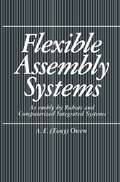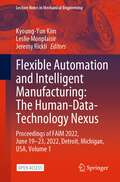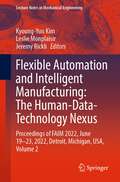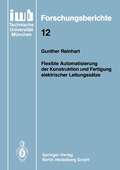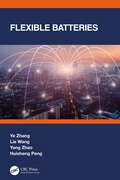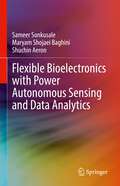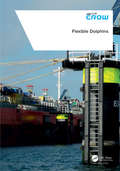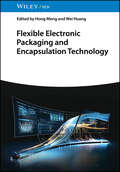- Table View
- List View
Flexible Assembly Systems: Assembly by Robots and Computerized Integrated Systems
by A.E. OwenIt has become clear in recent years from such major forums as the various international conferences on flexible manufacruring systems (FMSs) that the computer-controlled and -integrated "factory of the furure" is now being considered as a commercially viable and technically achievable goal. To date, most attention has been given to the design, development, and evalu ation of flexible machining systems. Now, with the essential support of increasing numbers of industrial examples, the general concepts, technical requirements, and cost-effectiveness of responsive, computer-integrated, flexible machining systems are fast becoming established knowledge. There is, of course, much still to be done in the development of modular com puter hardware and software, and the scope for cost-effective developments in pro gramming systems, workpiece handling, and quality control will ensure that contin uing development will occur over the next decade. However, international attention is now increasingly rurning toward the flexible computer control of the assembly process as the next logical step in progressive factory automation. It is here at this very early stage that Tony Owen has bravely set out to encompass the future field of flexible assembly systems (FASs) in his own distinctive, wide-ranging style.
Flexible Automation and Intelligent Manufacturing: Proceedings of FAIM 2022, June 19–23, 2022, Detroit, Michigan, USA (Lecture Notes in Mechanical Engineering)
by Kyoung-Yun Kim Leslie Monplaisir Jeremy RickliThis is an open access book. It gathers the first volume of the proceedings of the 31st edition of the International Conference on Flexible Automation and Intelligent Manufacturing, FAIM 2022, held on June 19 – 23, 2022, in Detroit, Michigan, USA. Covering four thematic areas including Manufacturing Processes, Machine Tools, Manufacturing Systems, and Enabling Technologies, it reports on advanced manufacturing processes, and innovative materials for 3D printing, applications of machine learning, artificial intelligence and mixed reality in various production sectors, as well as important issues in human-robot collaboration, including methods for improving safety. Contributions also cover strategies to improve quality control, supply chain management and training in the manufacturing industry, and methods supporting circular supply chain and sustainable manufacturing. All in all, this book provides academicians, engineers and professionals with extensive information on both scientific and industrial advances in the converging fields of manufacturing, production, and automation.
Flexible Automation and Intelligent Manufacturing: Proceedings of FAIM 2022, June 19–23, 2022, Detroit, Michigan, USA, Volume 2 (Lecture Notes in Mechanical Engineering)
by Kyoung-Yun Kim Leslie Monplaisir Jeremy RickliThis book gathers the second volume of the proceedings of the 31st edition of the International Conference on Flexible Automation and Intelligent Manufacturing, FAIM 2022, held on June 19 – 23, 2022, in Detroit, Michigan, USA. Covering four thematic areas including Manufacturing Processes, Machine Tools, Manufacturing Systems, and Enabling Technologies, it highlights advances in micro- and nanoscales processes, additive manufacturing, artificial intelligence and robotic applications, human-robot collaboration, as well as quality control, supply chain, industrial monitoring and management strategies. It also discusses important issues related to sustainability, waste management and remanufacturing. All in all, this book provides academicians, engineers and professionals with extensive information on both scientific and industrial advances in the converging fields of manufacturing, production, and automation.
Flexible Automation and Intelligent Manufacturing: Proceedings of FAIM 2023, June 18–22, 2023, Porto, Portugal, Volume 2: Industrial Management (Lecture Notes in Mechanical Engineering)
by Carla M. A. Pinto José Carlos Sá Francisco J. G. Silva Luís Pinto Ferreira Maria Teresa PereiraThis book reports on cutting-edge research and developments in manufacturing, giving a special emphasis to solutions fostering automation, sustainability and health, safety and well-being at work. Topics cover manufacturing process analysis and optimization, supply chain management, quality control, as well as human factors and logistics. They highlight the role and advantages of intelligent systems and technologies, discussing current best-practices and challenges to cope with in the near future. Based on proceedings of the 32nd edition of the International Conference on Flexible Automation and Intelligent Manufacturing, FAIM 2023, held on June 18–22, 2023, in Porto, Portugal, this second volume of a 2-volume set provides academics and professionals with extensive information on innovative strategies for industrial management in the era of industry 5.0.
Flexible Automation and Intelligent Manufacturing: Proceedings of FAIM 2023, June 18–22, 2023, Porto, Portugal, Volume 1: Modern Manufacturing (Lecture Notes in Mechanical Engineering)
by Francisco J. G. Silva António B. Pereira Raul D. S. G. CampilhoThis book reports on cutting-edge research and developments in manufacturing, giving a special emphasis to solutions fostering automation and sustainability. Topics cover manufacturing process optimization, remanufacturing, machines and mechanical design, CAD/CAM/CAE, materials characterization and processing, measurement and predictive maintenance techniques. Further topics include artificial intelligence and IoT in manufacturing, robotics, and cutting-edge issues in Industry 4.0/5.0. Based on proceedings of the 32nd edition of the International Conference on Flexible Automation and Intelligent Manufacturing, FAIM 2023, held on June 18 – 22, 2023, in Porto, Portugal, this first volume of a 2-volume set provides academics and professionals with extensive, technical information on trends and technologies in manufacturing, yet it also discusses challenges and practice-oriented experience in all the above-mentioned areas.
Flexible Automation in Japan
by J. HartleyMuch has been said and written about Japan's manufacturing prowess. Most ofthe comment comes from people who are merely visitors to the country and can be best cIassified as 'observers looking in from the outside'. Other views come from the Japanese themselves in which the double barrier of culture and language filters out much information that would be of real value to Western industrialists. Neither of these limitations apply to John Hartley, who has been resident in Japan for the past five years. He understands the culture, can speak the language and has extensive contacts at the highest level. Therefore, he is in a unique position to report on the Japanese scene and its activities in advanced manufacturing technology. This he has been doing on a regular basis to IFS magazines: The Industrial Robot, Assembly Automation, Sensor Review and The FMS Magazine. Most of the material in this book is from John Hartley's 'pen' and represents his most significant contributions on flexible automation in Japan to these journals over the last three years. It is augmented with a few other articles written by leading authorities on new technology in Japanese manufacturing industry.
Flexible Automatisierung der Konstruktion und Fertigung elektrischer Leitungssätze (iwb Forschungsberichte #12)
by Gunther ReinhartFlexible Batteries
by Ye Zhang Lie Wang Yang Zhao Huisheng PengFlexible Batteries highlights the key advances in flexible batteries, a booming new direction in the energy storage field. The authors first introduce lithium-ion batteries, which are currently the most widely used batteries. Flexible aqueous batteries such as aqueous lithium-ion, sodium-ion, and zinc-ion batteries are discussed subsequently due to the safety concerns in organic electrolytes. Since flexible metal-air batteries are recognized as primary choices for the next generation, the authors take lithium-air and aluminum-air batteries as examples to explore their applications in flexible battery construction. They further summarize flexible batteries under the most challenging working conditions such as stretching and integrating flexible batteries with flexible energy harvesting devices, sensors, and supercapacitors. Covering both fundamental and application development, this book may effectively bridge academics and industry. It will be helpful not only to scholars and students studying materials science and engineering, chemical engineering, physics, energy science, and biomedical science but also to scientists and engineers in the industry.
Flexible Batteries
by Ye Zhang Lie Wang Yang Zhao Huisheng PengFlexible Batteries highlights the key advances in flexible batteries, a booming new direction in the energy storage field. The authors first introduce lithium-ion batteries, which are currently the most widely used batteries. Flexible aqueous batteries such as aqueous lithium-ion, sodium-ion, and zinc-ion batteries are discussed subsequently due to the safety concerns in organic electrolytes. Since flexible metal-air batteries are recognized as primary choices for the next generation, the authors take lithium-air and aluminum-air batteries as examples to explore their applications in flexible battery construction. They further summarize flexible batteries under the most challenging working conditions such as stretching and integrating flexible batteries with flexible energy harvesting devices, sensors, and supercapacitors. Covering both fundamental and application development, this book may effectively bridge academics and industry. It will be helpful not only to scholars and students studying materials science and engineering, chemical engineering, physics, energy science, and biomedical science but also to scientists and engineers in the industry.
Flexible Bioelectronics with Power Autonomous Sensing and Data Analytics
by Sameer Sonkusale Maryam Shojaei Baghini Shuchin AeronThis book provides readers with an introduction to the materials and devices necessary for flexible sensors and electronics, followed by common techniques for fabrication of such devices and system-level integration. Key insights into fabrication and processing will guide readers through the tradeoff choices in designing such platforms. A comprehensive review of two specific, flexible bioelectronic platforms, related to smart bandages for wound monitoring and thread-based diagnostics for wearable health, will demonstrate practical application at the system level. The book also provides a unique electrical engineering perspective by reviewing circuit architectures for low noise signal conditioning of weak signals from sensors,, and for low power analog to digital converters for signal acquisition. To achieve energy autonomy, authors provide several example of CMOS energy harvesting front end circuits and voltage boosters. Beyond circuit architectures, the book also provides a review of the modern theory of sampling and recovery of sparse signals, also known as compressed sensing. They then highlight how these principles can be leveraged for design and implementation of efficient signal acquisition hardware and reliable processing of acquired data for flexible electronic platforms.
Flexible Carbon-based Electronics (Advanced Nanocarbon Materials)
by Xinliang FengThis third volume in the Advanced Nanocarbon Materials series covers the topic of flexible electronics both from a materials and an applications perspective. Comprehensive in its scope, the monograph examines organic, inorganic and composite materials with a section devoted to carbon-based materials with a special focus on the generation and properties of 2D materials. It also presents carbon modifications and derivatives, such as carbon nanotubes, graphene oxide and diamonds. In terms of the topical applications covered these include, but are not limited to, flexible displays, organic electronics, transistors, integrated circuits, semiconductors and solar cells. These offer perspectives for today?s energy and healthcare challenges, such as electrochemical energy storage and wearable devices. Finally, a section on fundamental properties and characterization approaches of flexible electronics rounds off the book. Each contribution points out the importance of the structure-function relationship for the target-oriented fabrication of electronic devices, enabling the design of complex components.
Flexible Carbon-based Electronics (Advanced Nanocarbon Materials)
by Xinliang FengThis third volume in the Advanced Nanocarbon Materials series covers the topic of flexible electronics both from a materials and an applications perspective. Comprehensive in its scope, the monograph examines organic, inorganic and composite materials with a section devoted to carbon-based materials with a special focus on the generation and properties of 2D materials. It also presents carbon modifications and derivatives, such as carbon nanotubes, graphene oxide and diamonds. In terms of the topical applications covered these include, but are not limited to, flexible displays, organic electronics, transistors, integrated circuits, semiconductors and solar cells. These offer perspectives for today?s energy and healthcare challenges, such as electrochemical energy storage and wearable devices. Finally, a section on fundamental properties and characterization approaches of flexible electronics rounds off the book. Each contribution points out the importance of the structure-function relationship for the target-oriented fabrication of electronic devices, enabling the design of complex components.
Flexible Databases Supporting Imprecision and Uncertainty (Studies in Fuzziness and Soft Computing #203)
by Gloria Bordogna Giuseppe PsailaThis volume offers the advice of selected expert contributors on the application of heterogeneous methods for managing uncertainty and imprecision in databases. It contains both survey chapters on classic topics such as "flexible querying in databases", and up to date information on "database models to represent imperfect data". Further, it includes specific contributions on uncertainty management in database integration, and in representing and querying semistructured and spatial data.
Flexible Dolphins
by CrowMillions of breasting and mooring dolphins have been installed in inland waterways adjacent to jetties and waiting facilities for ship-to-ship transhipment or as crash barriers in commercial port areas throughout the world. A dolphin is a marine structure that is frequently installed in ports, waterways and other places related to marine traffic. Dolphins are typically located adjacent to waterfront structures such as quay walls, jetties, locks and bridge piers. The purpose of a dolphin is threefold: Allow ships to berth and moor safely and efficiently Protect waterfront structures by acting as a crash barrier and sacrificial structure Direct and guide marine traffic by acting as a lead-in dolphin and navigation aid The main objective of this handbook is to provide engineers, asset managers, suppliers, tender teams, contractors and principals with such guidance on the design and construction of flexible dolphins by collecting and describing knowledge of and experience with these flexible marine structures.This handbook is intended to prevent extensive discussions during the design and construction stages of projects involving flexible dolphins. It is part of a series of Dutch port infrastructure design recommendations that include the Quay Walls handbook and Jetties and Wharfs handbook.
Flexible Dolphins
by CrowMillions of breasting and mooring dolphins have been installed in inland waterways adjacent to jetties and waiting facilities for ship-to-ship transhipment or as crash barriers in commercial port areas throughout the world. A dolphin is a marine structure that is frequently installed in ports, waterways and other places related to marine traffic. Dolphins are typically located adjacent to waterfront structures such as quay walls, jetties, locks and bridge piers. The purpose of a dolphin is threefold: Allow ships to berth and moor safely and efficiently Protect waterfront structures by acting as a crash barrier and sacrificial structure Direct and guide marine traffic by acting as a lead-in dolphin and navigation aid The main objective of this handbook is to provide engineers, asset managers, suppliers, tender teams, contractors and principals with such guidance on the design and construction of flexible dolphins by collecting and describing knowledge of and experience with these flexible marine structures.This handbook is intended to prevent extensive discussions during the design and construction stages of projects involving flexible dolphins. It is part of a series of Dutch port infrastructure design recommendations that include the Quay Walls handbook and Jetties and Wharfs handbook.
Flexible Electronic Packaging and Encapsulation Technology
by Wei Huang Hong MengFlexible Electronic Packaging and Encapsulation Technology A systematic introduction to the future of electronic packaging Electronic packaging materials are among the most important components of the broader electronics industry, capable of facilitating heat dissipation, redistributing stress on electronic components, and providing environmental protections for electronic systems. Recent advances in integrated circuits, especially the development of flexible electronic technology, have placed increasingly stringent demands on the capabilities of electronic packaging. These technologies have the potential to reshape our world, and they demand a generation of engineers capable of harnessing that potential. Flexible Electronic Packaging and Encapsulation Technology meets this demand with an introduction to the cutting-edge technologies available to package electronic components, as well as the testing methods and applications that bring these technologies to bear on the industry. These packaging technologies promise to bring lightness, flexibility, and environmental friendliness to the next generation of electronic systems. Flexible Electronic Packaging and Encapsulation Technology readers will also find: Survey of commercial electronic packaging materials and patents for reference purposesGuidelines for designing high-performance packaging materials with novel structuresAn authorial team of leading researchers in the field Flexible Electronic Packaging and Encapsulation Technology is ideal for materials scientists, electronics engineers, solid state physicists, professionals in the semiconductor industry, and any other researchers or professionals working with electronic systems.
Flexible Electronic Packaging and Encapsulation Technology
by Hong MengFlexible Electronic Packaging and Encapsulation Technology A systematic introduction to the future of electronic packaging Electronic packaging materials are among the most important components of the broader electronics industry, capable of facilitating heat dissipation, redistributing stress on electronic components, and providing environmental protections for electronic systems. Recent advances in integrated circuits, especially the development of flexible electronic technology, have placed increasingly stringent demands on the capabilities of electronic packaging. These technologies have the potential to reshape our world, and they demand a generation of engineers capable of harnessing that potential. Flexible Electronic Packaging and Encapsulation Technology meets this demand with an introduction to the cutting-edge technologies available to package electronic components, as well as the testing methods and applications that bring these technologies to bear on the industry. These packaging technologies promise to bring lightness, flexibility, and environmental friendliness to the next generation of electronic systems. Flexible Electronic Packaging and Encapsulation Technology readers will also find: Survey of commercial electronic packaging materials and patents for reference purposesGuidelines for designing high-performance packaging materials with novel structuresAn authorial team of leading researchers in the field Flexible Electronic Packaging and Encapsulation Technology is ideal for materials scientists, electronics engineers, solid state physicists, professionals in the semiconductor industry, and any other researchers or professionals working with electronic systems.
Flexible Electronics: Theory and Method of Structural Design
by YongAn Huang YeWang Su Shan JiangFlexible electronics are electronics that can be stretched, bent, twisted, and deformed into arbitrary shapes. They break through the bottleneck and monopoly of traditional, rigid IC technologies and represent the next-generation electronics. This book provides an overview of the underlying theory and method of structural design for flexible electronics. Compared to intrinsically flexible and stretchable materials, structural engineering has proven its unique advantages, e.g. stretchable inorganic electronics. Based on the mechanical mechanisms, this book discusses the main structural deformation behaviors of flexible electronics, including mechanics of film-on-substrate and fiber-on-substrate, self-similar design with/without substrate, conformal design on rigid/soft substrate, purely in-plane design of serpentine interconnect with/without substrate, buckling-driven self-assembly and kirigami assembly strategies, neutral layer design, and the new materials-based structure design like liquid metals, etc. Moreover, the related advanced fabrication technology, the devices designs and applications of flexible electronics are also presented. The comprehensive and in-depth content makes this book can be used as a reference book for experienced researchers, as well as a teaching material for graduate students.
Flexible Electronics: Materials and Applications (Electronic Materials: Science & Technology #11)
by Alberto Salleo William S. WongThis excellent volume covers a range of materials used for flexible electronics, including semiconductors, dielectrics, and metals. The functional integration of these different materials is treated as well. Fundamental issues for both organic and inorganic materials systems are included. A corresponding overview of technological applications, based on each materials system, is presented to give both the non-specialist and the researcher in the field relevant information on the status of the flexible electronics area.
Flexible Electronics for Electric Vehicles: Select Proceedings of FlexEV—2021 (Lecture Notes in Electrical Engineering #863)
by Sanjeet Dwivedi Sanjeev Singh Manish Tiwari Ashish ShrivastavaThis book compiles the refereed papers presented during the 2nd Flexible Electronics for Electric Vehicles (FlexEV - 2021). It presents the diligent work of the research community on flexible electronics applications in different allied fields of engineering - engineering materials to electrical engineering to electronics and communication engineering. The theoretical research concepts are supported with extensive reviews highlighting the trends in the possible and real-life applications of electric vehicles. This book will be useful for research scholars, electric vehicles professionals, driving system designers, and postgraduates from allied domains. This book incorporates economical and efficient electric vehicle driving and the latest innovations in electric vehicle technology with their paradigms and methods that employ knowledge in the research community.
Flexible Electronics for Electric Vehicles: Proceedings of the 3rd International Conference, FlexEV 2022 (Lecture Notes in Electrical Engineering #1065)
by Sunil Kumar Goyal Dheeraj Kumar Palwalia Rajiv Tiwari Yeshpal GuptaThis volume comprises the select proceedings of the 3rd Conference on Flexible Electronics for Electric Vehicles (FlexEV 2022). It aims to provide a comprehensive and broad-spectrum picture of the state-of-the-art research and development in flexible electronics & applications, electric vehicle technology & infrastructures, materials & devices, battery management & intelligent systems. This volume will prove a valuable resource for those in academia and industry.
Flexible Energy Conversion and Storage Devices
by Chunyi Zhi Liming DaiProvides in-depth knowledge of flexible energy conversion and storage devices-covering aspects from materials to technologies Written by leading experts on various critical issues in this emerging field, this book reviews the recent progresses on flexible energy conversion and storage devices, such as batteries, supercapacitors, solar cells, and fuel cells. It introduces not only the basic principles and strategies to make a device flexible, but also the applicable materials and technologies, such as polymers, carbon materials, nanotechnologies and textile technologies. It also discusses the perspectives for different devices. Flexible Energy Conversion and Storage Devices contains chapters, which are all written by top researchers who have been actively working in the field to deliver recent advances in areas from materials syntheses, through fundamental principles, to device applications. It covers flexible all-solid state supercapacitors; fiber/yarn based flexible supercapacitors; flexible lithium and sodium ion batteries; flexible diversified and zinc ion batteries; flexible Mg, alkaline, silver-zinc, and lithium sulfur batteries; flexible fuel cells; flexible nanodielectric materials with high permittivity for power energy storage; flexible dye sensitized solar cells; flexible perovskite solar cells; flexible organic solar cells; flexible quantum dot-sensitized solar cells; flexible triboelectric nanogenerators; flexible thermoelectric devices; and flexible electrodes for water-splitting. -Covers the timely and innovative field of flexible devices which are regarded as the next generation of electronic devices -Provides a highly application-oriented approach that covers various flexible devices used for energy conversion and storage -Fosters an understanding of the scientific basis of flexible energy devices, and extends this knowledge to the development, construction, and application of functional energy systems -Stimulates and advances the research and development of this intriguing field Flexible Energy Conversion and Storage Devices is an excellent book for scientists, electrochemists, solid state chemists, solid state physicists, polymer chemists, and electronics engineers.
Flexible Energy Conversion and Storage Devices
by Chunyi Zhi Liming DaiProvides in-depth knowledge of flexible energy conversion and storage devices-covering aspects from materials to technologies Written by leading experts on various critical issues in this emerging field, this book reviews the recent progresses on flexible energy conversion and storage devices, such as batteries, supercapacitors, solar cells, and fuel cells. It introduces not only the basic principles and strategies to make a device flexible, but also the applicable materials and technologies, such as polymers, carbon materials, nanotechnologies and textile technologies. It also discusses the perspectives for different devices. Flexible Energy Conversion and Storage Devices contains chapters, which are all written by top researchers who have been actively working in the field to deliver recent advances in areas from materials syntheses, through fundamental principles, to device applications. It covers flexible all-solid state supercapacitors; fiber/yarn based flexible supercapacitors; flexible lithium and sodium ion batteries; flexible diversified and zinc ion batteries; flexible Mg, alkaline, silver-zinc, and lithium sulfur batteries; flexible fuel cells; flexible nanodielectric materials with high permittivity for power energy storage; flexible dye sensitized solar cells; flexible perovskite solar cells; flexible organic solar cells; flexible quantum dot-sensitized solar cells; flexible triboelectric nanogenerators; flexible thermoelectric devices; and flexible electrodes for water-splitting. -Covers the timely and innovative field of flexible devices which are regarded as the next generation of electronic devices -Provides a highly application-oriented approach that covers various flexible devices used for energy conversion and storage -Fosters an understanding of the scientific basis of flexible energy devices, and extends this knowledge to the development, construction, and application of functional energy systems -Stimulates and advances the research and development of this intriguing field Flexible Energy Conversion and Storage Devices is an excellent book for scientists, electrochemists, solid state chemists, solid state physicists, polymer chemists, and electronics engineers.
Flexible Engineering Toward Green Aircraft: CAE Tools for Sustainable Mobility (Lecture Notes in Applied and Computational Mechanics #92)
by Marco Evangelos Biancolini Ubaldo CellaThis book discusses the recent advances in aircraft design methodologies. It provides an overview of topics such as shape optimization, robust design and aeroelasticity, focusing on fluid-structure numerical methodologies to address static and dynamic aeroelastic problems. It demonstrates that the capability to evaluate the interaction between aerodynamics, inertia and elastic forces is important to avoid drag penalties, control system efficiency loss and generation of potentially dangerous phenomena, such as divergence, control reversal and flutter. The book particularly highlights the advances in “high fidelity” CFD-CSM coupling, describing the latest experimental research to validate the numerical fluid-structure interaction analysis methodologies resulting from the EU-funded RBF4AERO and RIBES projects.
